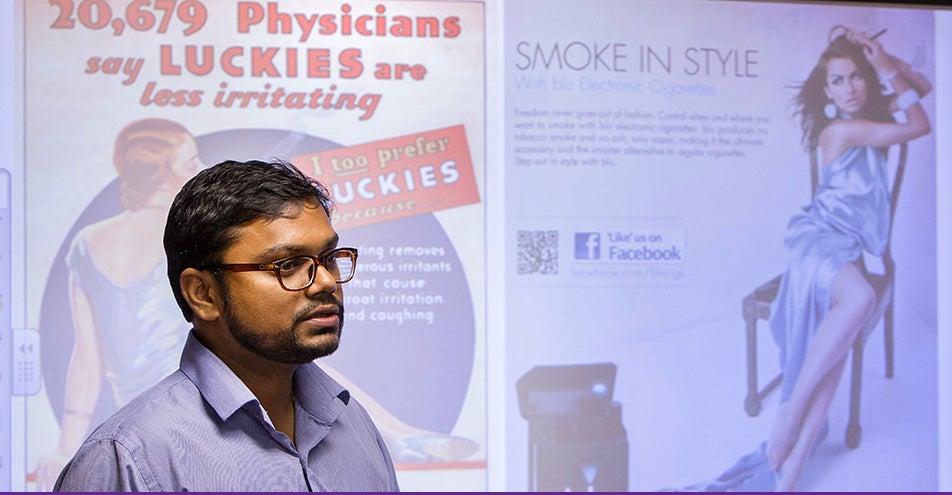GATEWAY TO ADDICTION
ECU psychiatrist unveils NC teens’ views about e-cigarettes
An East Carolina University psychiatrist has published research that shows what adolescents in eastern North Carolina think of electronic cigarettes and how they’re using them.
Dr. Vivek Anand, clinical assistant professor of child and adolescent psychiatry at ECU’s Brody School of Medicine, surveyed about 3,000 public high school students to determine their attitudes and habits around the practice commonly referred to as “vaping.”
Of those who completed the 47-question survey, 15.2 percent reported having tried an e-cigarette, and 7.4 percent had smoked one during the 30 days prior to the survey.
Anand’s findings coincide with federal data released in April 2015 by the U.S. Centers for Disease Control and Prevention showing e-cigarette use tripled among American teens last year, eclipsing all forms of tobacco usage.
Available in the U.S. since 2007, e-cigarettes are battery-powered devices that heat up nicotine-laced fluid, turning it into an aerosol that can be inhaled. Nicotine is the addictive chemical responsible for the calming effect experienced by users of traditional tobacco products. Vaping liquid is available in a variety of flavors and nicotine levels. In North Carolina, the devices and cartridges are sold to adults at retail stores and gas stations, but minors often purchase them online or through older friends.
When e-cigarettes first became popular, many viewed them as a way to quit tobacco, but Anand said there is mounting evidence to the contrary. Of the student respondents who were e-cigarette users, 75 percent reported using tobacco as well, thus accelerating their dependency and increasing their risk for nicotine poisoning. Compounding the problem are the relative convenience of vaping and the absence of the social stigma that surrounds tobacco use.
“What’s especially troubling is how young these kids are starting,” Anand said. Drugs like nicotine can significantly inhibit brain development until a person is in their early twenties, he explained. The average age of students he surveyed was 16.4.
“The earlier a person’s nicotine exposure, the more quickly their brain is primed for long-term dependence, and the more likely they are to begin a trajectory of other drug use,” Anand said. “Vaping is a gateway into – not a pathway out of – harmful addiction.”
An alarming 60 percent of students Anand surveyed thought e-cigarettes were completely safe or posed minimal health hazards. Many students thought they contained only water.
Because most e-cigarettes contain hefty amounts of nicotine, they increase the user’s risk for health problems historically associated with regular tobacco use, like stroke and heart attack. But they include other potentially harmful substances, as well, Anand said. One is formaldehyde, an airway and skin irritant that’s also widely considered a carcinogen.
“In January 2014 there were 7,764 unique flavors of e-cigs documented, and every one of them is a chemical,” Anand said. “People are even making their own mixtures with additional herbs and marijuana. People have no idea what they’re smoking. I see health advocates getting more and more perplexed because there are just so many unknowns.”
Anand said he isn’t surprised teens are attracted to vaping. “E-cigarettes appeal to the adolescent’s curiosity, to their search for autonomy and novelty,” he said. “E-cigs look like digital toys. They taste like candy. They’re advertised on popular social media sites. They’re endorsed by celebrities.”
While tobacco products can no longer be advertised on television, e-cigarettes can. And some manufacturers – many of whom are large tobacco-cigarette companies – are spending billions of dollars on campaigns that target youth, especially those in major tobacco-growing states like North Carolina. In fact, many opponents claim these campaigns mirror the images and themes tobacco companies used to successfully market traditional cigarettes to youth 50 years ago.
Anand hopes his findings will influence policy through advertising restrictions and mandated school-based education programs. He’d also like to see e-cigarettes subjected to regulation by the U.S. Food and Drug Administration, and health-warning labels and ingredient lists required on their packaging.
Much research remains to be done to investigate the long-term health consequences of vaping, Anand said. For now, doctors and patients should rely only on those tobacco-cessation resources that have been scientifically tested, he said.
“Many doctors will ask a patient, ‘do you smoke?’ and the patient will say ‘no.’ But that patient does vape,” Anand said. “At this point, we’re not even asking the right questions.”
The study was funded by the American Academy of Child and Adolescent Psychiatry Resident Research Award in Substance Abuse and Addiction, supported by the National Institute on Drug Abuse. ECU child/adolescent psychiatrist Dr. Kaye McGinty and Dr. Kevin O’Brien of ECU’s biostatistics department collaborated with Anand on the study. Their findings are published in the June 2015 edition of the Journal of Adolescent Health.
